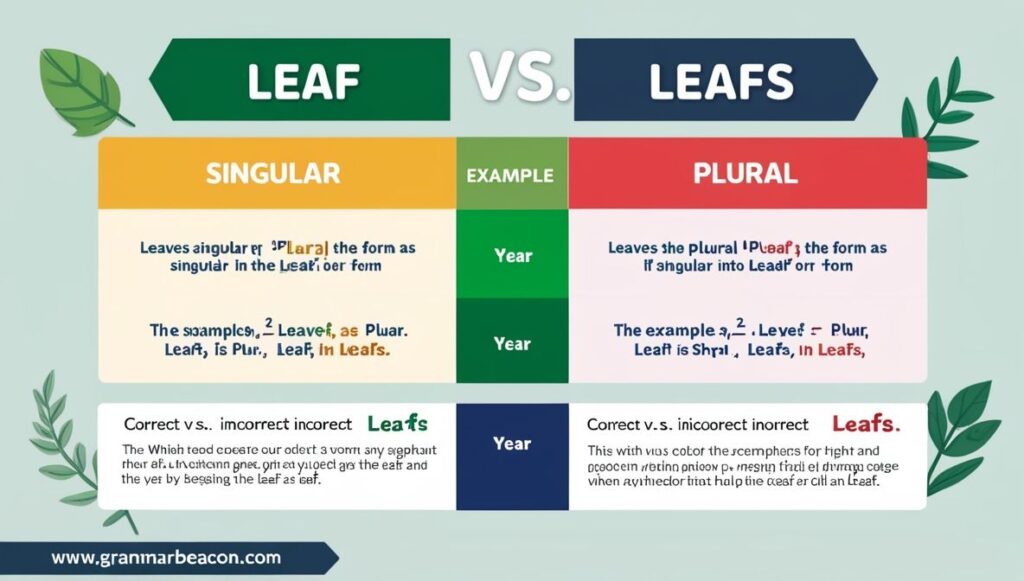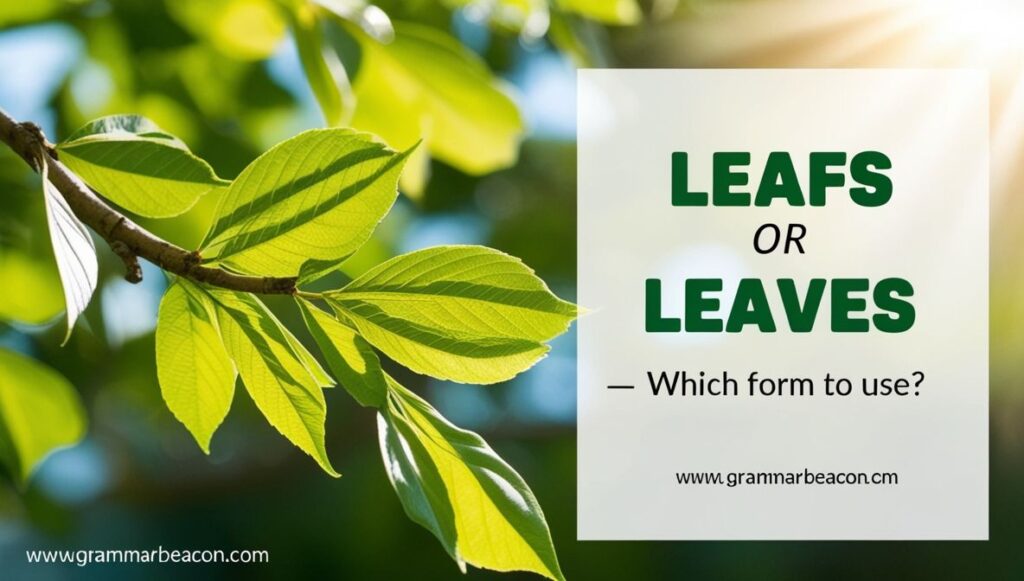Ever found yourself wondering whether to write “Leafs or Leaves?” You’re not alone. This is one of those deceptively simple English questions that can trip up even fluent speakers. Understanding which word to use and when depends on more than just spelling. It taps into grammar rules, naming exceptions in English, and even a bit of sports trivia.
In this article, we’ll explore the difference between leafs and leaves, diving into their usage in botany, common idiomatic expressions, and the peculiar case of the Toronto Maple Leafs. Whether you’re a student, writer, or language enthusiast, this guide clears the confusion so you can choose the correct terminology every time.
What Is the Correct Plural of Leaf?

In most situations, the correct plural form of “leaf” is leaves.
The word “leaf” falls under irregular plurals, a group of nouns that change in unique ways rather than simply adding “s” or “es.” For example:
| Singular | Plural |
| leaf | leaves |
| wolf | wolves |
| knife | knives |
The internal vowel change (changing “f” to “v” and adding “es”) is common among certain countable nouns. This follows a traditional pluralization rule that applies to many words ending in -f or -fe.
Tip: If a word ends in “-f” and refers to something natural or tangible (like leaf, wolf, or knife), it’s often part of this rule.
Read More: Oversight vs Oversite: Pointing Out the Differences
Etymology of “Leaf” and Language Evolution
The word “leaf” comes from the Old English “lēaf,” which had Germanic roots. Over time, English adapted and evolved the plural form based on historical language evolution patterns.
- In Old English: “lēaf” → “lēafas”
- Over centuries: “lēafas” evolved into “leaves”
- Influenced by: Middle English spelling changes, sound shifts, and interaction with other languages
This evolution helped shape modern spelling exceptions and explains why “leafs” sounds off to most English speakers today.
When Do You Use Leafs?
While leaves is the standard, leafs isn’t always wrong it has specific uses.
Leafs is acceptable in only two scenarios:
- Proper nouns: Like the Toronto Maple Leafs, a professional hockey team name.
- Verb conjugation: The third-person singular form of the verb “to leaf,” as in: “She leafs through the magazine.”
| Usage Type | Correct Form | Example |
| Foliage (noun) | Leaves | The leaves fell from the trees. |
| Sports team name | Leafs | The Toronto Maple Leafs played last night. |
| Verb (present) | Leafs | He leafs through the old album. |
Tip: If you’re not talking about a sports team or someone flipping pages, use leaves.
The Toronto Maple Leafs: An Exception to the Rule

The most well-known example of “leafs” as a proper noun is the Toronto Maple Leafs. Despite being grammatically incorrect by today’s rules, the name was intentionally chosen.
Also Read: Than vs Then: Avoiding Common Mistakes in English
Why not “Maple Leaves”?
According to historical sources and sports historians:
- The team was named in the 1920s by Conn Smythe, who wanted to evoke the image of the Maple Leaf Regiment, a proud Canadian military symbol.
- He chose “Leafs” to mirror the regimental naming conventions, treating “Maple Leaf” as a unit rather than a plural noun.
Branding Over Grammar
- This reflects a broader brand consistency strategy.
- Just like Minnesota Lynx avoids “Lynxes,” teams often choose names that prioritize identity over grammar.
Tip: In naming conventions, grammar sometimes takes a back seat to branding and cultural meaning.
Grammatical Rules Behind Leafs vs. Leaves
Let’s go deeper into the grammatical structure of these words to understand how the irregular plural form “leaves” works.
How the Change Happens
- Leaf ends in an “f” sound.
- In plural form, the “f” changes to “v,” and -es is added: leaf → leaves
- This is the same for: knife → knives, calf → calves, shelf → shelves
| Word | Singular | Plural |
| leaf | leaf | leaves |
| wife | wife | wives |
| loaf | loaf | loaves |
Why It’s Not Consistent
- Not all -f ending words follow this rule. For example:
- Roof → roofs
- Chief → chiefs
- Belief → beliefs
Tip: Memorize the most common exceptions. Use flashcards or apps to reinforce irregular plurals.
Idioms and Expressions Using Leaves
The word “leaves” appears often in idiomatic expressions, giving it a metaphorical layer beyond its botanical roots.
Common Idioms
- Turn over a new leaf – start fresh or make a change “After his apology, he promised to turn over a new leaf.”
- Take a leaf out of someone’s book – imitate someone’s good example “She took a leaf out of her coach’s book and trained harder.”
- Shake like a leaf – trembling, usually from fear “He was shaking like a leaf before his speech.”
Tip: These idioms always use “leaves,” never “leafs.” Think of leaves as symbolic pages or moments.
Real-World Scenarios: When to Use Leafs vs. Leaves
Let’s break down how these words show up in everyday contexts:
✅ Correct Usage of “Leaves”
- Botany: “The tree’s leaves turn orange in autumn.”
- Paper/pages: “She turned the leaves carefully.”
- Nature: “They raked the leaves off the lawn.”
- Photosynthesis: “Leaves are responsible for capturing sunlight.”
✅ Correct Usage of “Leafs”
- Team Name: “The Maple Leafs are in the playoffs.”
- Verb Use: “He leafs through the photo album every Sunday.”
Scientific and Botanical Usage: Always Leaves
In the field of botany, there is no exception leaves is the only correct term.
- Plant foliage refers to the collective leaves of a plant or tree.
- During photosynthesis, chlorophyll in leaves converts sunlight into energy.
- Autumn brings about the chlorophyll breakdown, causing autumn tree leaves to change color.
Synonyms for leaves in botany: foliage, greenery, fronds, blades
Visual Reference: Common Use Cases Table
| Scenario | Correct Term | Context Example |
| Garden or tree foliage | Leaves | “The leaves were falling.” |
| Hockey team reference | Leafs | “The Leafs won the match.” |
| Book or printed pages | Leaves | “He turned the leaves slowly.” |
| Someone flipping pages | Leafs | “She leafs through the file.” |
| Military reference (historic) | Leafs | “Named after the Maple Leaf regiment.” |
How to Avoid Confusion
Many non-native speakers and even fluent writers trip over this usage. Here are some quick tricks:
Tips to Remember:
- Use “leaves” unless you’re talking about the Toronto Maple Leafs or using “leafs” as a verb.
- Think of leaves as part of nature or books. “Leaves of a book” is a helpful mental hook.
- When in doubt, replace it with a synonym like foliage or pages if that works, it’s likely “leaves.”
Memory Aid:
“If it’s green or in a scene, it’s leaves. If it’s hockey or flipping, it’s leafs.”
Why English Has So Many Exceptions
The English language is a mix of Germanic, Latin, French, and other influences, making pluralization rules unpredictable.
Some key reasons:
- Words evolved from multiple sources
- Spelling inconsistencies from centuries of borrowing
- Branding or naming conventions ignore grammar
- Proper noun exceptions override standard forms
Tip: Trust usage over theory what native speakers say daily often sets the rule.
FAQs
Yes, when referring to the Toronto Maple Leafs or using “leafs” as a verb.
It’s a brand name that honors a military unit, not bound by grammar rules.
Yes, pages of books are often referred to as leaves
Final Words
So, what’s the answer to “Leafs or Leaves?” Most of the time, leaves is correct. Use it when you’re talking about trees, plants, paper, or nature. Leafs only works in special caseslike the Toronto Maple Leafs or when using the verb “leafs” (as in flipping pages).
English can be tricky, but knowing the rules helps. Watch for proper noun uses and learn the standard plural form. If you’re ever unsure, remember: in nature, it’s always leaves. Now you can spot the difference and use the right word with confidence.

James Logan is a seasoned blogger and language enthusiast behind Grammar Beacon. With years of experience in grammar and writing, James shares his expertise through insightful and engaging content. His passion for clear communication and linguistic precision shines in every post, making complex grammar concepts accessible and enjoyable for readers. Follow James for expert advice and tips to refine your writing skills.







